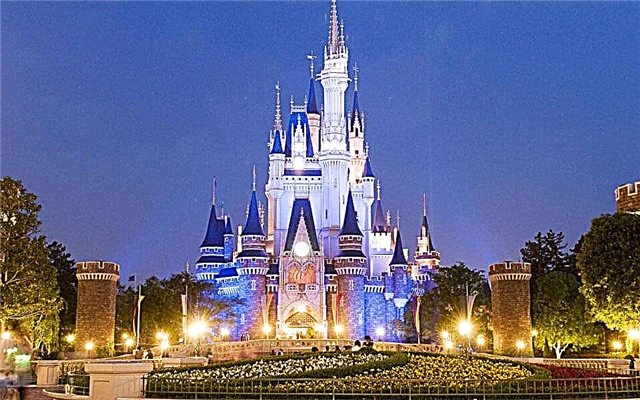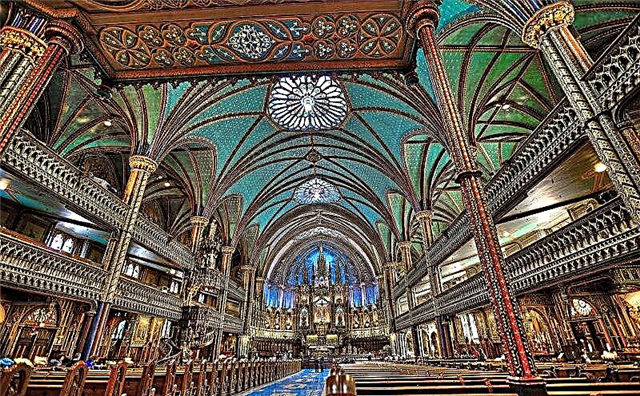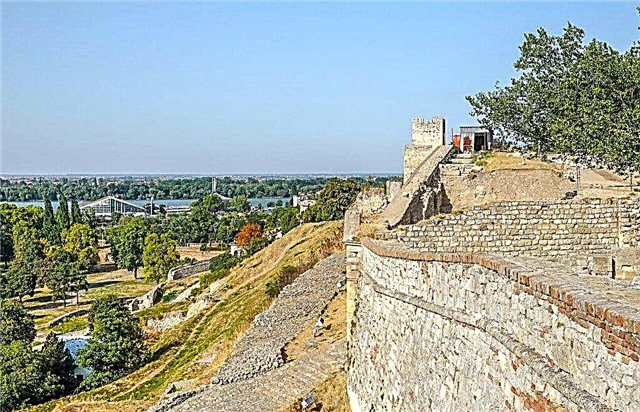Address: Russia, Moscow, Cathedral Square of the Moscow Kremlin
Start of construction: 1475 year
Completion of construction: 1479 year
Architect: Aristotle Fioravanti
Shrines: The nail of the Lord, the staff of St. Peter, Metropolitan of Kiev and All Russia
Coordinates: 55 ° 45'03.6 "N 37 ° 37'01.9" E
Content:
The Moscow Kremlin is the oldest historical and architectural complex, a landmark that Moscow can rightfully be proud of. The Assumption Cathedral, located on the territory of the Moscow Kremlin, for a very long time was the main temple of the capital.
The history of this temple, like many other Kremlin buildings, is interesting and eventful. Scientists-historians, conducting archaeological research, have found some dates on ancient burials under the opened floors of this cathedral. It is known for certain that long before the construction of the Assumption Cathedral, a wooden temple was built on the same site. It is also known that even in the 12th century it was not destroyed by time. What happened next is unclear, as, incidentally, there is no information about the wooden church itself.

View of the Cathedral from the Ivan the Great Bell Tower
Moscow becomes the capital - the beginning of the history of the Assumption Cathedral
After the residence of the Russian Metropolitan was moved to Moscow in 1326, the Grand Duke of Moscow Ivan Kalita, on the advice of Vladyka Peter, decided to start laying the foundation for a new stone cathedral. The fact is that the church could no longer satisfy the ambitions of both ecclesiastical and secular authorities that were arising at that time. For the main metropolitan church, the wooden church was too small, and for the residence of the metropolitan - not solid enough. Generally August 1326 was the year of the foundation stone of the Cathedral of the Dormition... It is difficult to say with absolute certainty which temple was the prototype for the construction of a new one, but the versions of authoritative historians agree on this issue to the St. George Cathedral, located in Yuryev-Polsky.
And already in 1327 the first stone church was erected in Moscow. Its location is the highest point on the Kremlin Hill, which is why the cathedral received the interesting historical name "Cathedral on Makovitsa".

View of the eastern facade of the cathedral
Destruction of the "Cathedral on Makovice"
Unfortunately, there are no eternal buildings, and if they are not seriously dealt with, sooner or later they fall into decay. Although the reason for the strong dilapidation of the cathedral, built during the time of Ivan Kalita, is rather the constantly occurring fires. Yes, after a century and a half, the temple was battered so that the question of total reconstruction, or a new building arose by itself. Having weighed all the pros and cons (strongly crumbling stone, and the dilapidation of some structures - the vaults had to be propped up with logs), after a fire that occurred again in 1470, it was decided to dismantle the old cathedral and build a new one.
About the history of the Assumption Cathedral in the 15th century
The construction of a new cathedral began in 1472. There is much more information about this cathedral - in particular, even the names of the master architects are known: a certain Krivtsov and Myshkin. The Assumption Cathedral in Vladimir was taken as a model for the construction of a new church.... The construction of the renewed "version" of the stone church was approached thoroughly.

Cathedral domes
The construction took so long that, in order not to interrupt the course of the church service, a temporary church made of wood was even built on the site of the altar of the old temple. This church is notable for the fact that it was in it that the wedding of Tsar Ivan 3 with Sophia Palaeologus, a princess from Byzantium, took place. And this memorable event happened in November 1472. Further - more: the newly built cathedral, which almost reached the final phase of construction, collapsed.
The reason was very simple - the imperfection of building technologies at that time. Which is quite understandable, because the then Russia was just transitioning from wooden construction to stone construction. The solution, which was prepared by Russian master architects as a binding material, turned out to be fragile and liquid. Ivan 3 first summoned the Pskov architects to carry out the reconstruction, but they looked, shook their heads, smacked their lips and refused. Then Ivan 3 decided to act completely unconventional and set out to invite the builders of the new church directly from Italy!

View of the Cathedral from Cathedral Square
No sooner had the appropriate order matured in the tsarist office than Ivan 3 completely decided on the choice - he was Ridolfo Aristotle Fioravanti, more an engineer than an architect, who was engaged in the ebb and lifting of bells on belfries. In addition, Fioravanti specialized in the laying of water canals, the construction and restoration of bridges. Fiorovanti was renowned for his engineering work in both Hungary and Italy.
Once again, the construction of the new Assumption Cathedral was completed by 1479, 2 years later the temple was covered with church paintings. Russian architects, looking at the overseas construction techniques of a stranger, were surprised by new technologies. Particularly "theirs" mistrust was caused by the vaults, the thickness of which was no more than one brick. It was thought that the ceiling would leak during rains, but this did not happen. For the first time in Russian stone buildings, metal rods were used, and the way they were supplied to the right places was extremely unusual - on blocks with wheels.

View of the cathedral from the Ivanovskaya square
But the most important innovation was not even a combination of individual techniques and technologies, but in the internal configuration of the cathedral - it essentially had a single space, in which several pillars were used as supports. There were also no side-altars, which had never been before in the architectural branch of Russia.
New life of the Assumption Cathedral
The construction of a new church under the guidance of an Italian master literally breathed new life into the cathedral. So at the end of the 15th century, the grandson of Ivan 3 Demetrius was crowned here on the principality, and already in 1547 the notorious Ivan the Terrible was crowned here.... Moreover, the Assumption Cathedral in the Kremlin did not lose its state significance even after the transfer of the Russian capital to St. Petersburg. Since Peter the Great, it has become a good tradition to crown all Russian emperors only in the Assumption Cathedral. The Europeans, represented by the French Napoleonic warriors, did not hesitate to desecrate and burn down this temple in 1812, but during the war it was completely restored.

Entrance to the Cathedral from Cathedral Square
Assumption Cathedral in the 20th century ...
In the turbulent beginning of the 20th century, which the whole of Russia was going through, a fateful decision for the Russian Orthodox Church was made in the Assumption Cathedral that the patriarchate in Russia should be renewed. The ceremony of enthronement of Patriarch Tikhon was also held here. In the early years of Soviet power, the Assumption Cathedral was closed; the last church service was held in 1918 on Easter. It was this event that served as the plot for the painting of the famous Russian painter Pavel Korin "Departing Russia".
... and today
Today the Assumption Cathedral, located on the territory of the Moscow Kremlin, has the status of a museum, but church services in connection with the significant holidays of the Russian Orthodox Church are regularly held... The Assumption Cathedral did not receive the status of a cathedral in Moscow, although it is understandable - more than half a century of age of the temple makes it somewhat unsuitable for this kind of load. However, in a series of monuments to Russian Orthodoxy and Russian architecture, the Assumption Cathedral in the Kremlin still occupies one of the main places.











